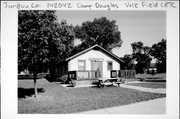Property Record
VOLK FIELD CRTC
Architecture and History Inventory
| Historic Name: | Building 413 |
|---|---|
| Other Name: | Building 413 |
| Contributing: | |
| Reference Number: | 142042 |
| Location (Address): | VOLK FIELD CRTC |
|---|---|
| County: | Juneau |
| City: | Camp Douglas |
| Township/Village: | |
| Unincorporated Community: | |
| Town: | 17 |
| Range: | 2 |
| Direction: | E |
| Section: | 21 |
| Quarter Section: | |
| Quarter/Quarter Section: |
| Year Built: | 1942 |
|---|---|
| Additions: | |
| Survey Date: | 2006 |
| Historic Use: | dining hall |
| Architectural Style: | Front Gabled |
| Structural System: | Masonry |
| Wall Material: | Tile |
| Architect: | Hengels, Henry C. |
| Other Buildings On Site: | |
| Demolished?: | No |
| Demolished Date: |
| National/State Register Listing Name: | Not listed |
|---|---|
| National Register Listing Date: | |
| State Register Listing Date: |
| Additional Information: | This enlisted men's mess hall was added to the Cavalry Regiment area by 1942. The mess hall was designed by Lt. Colonel Henry C. Hengels, State of Wisconsin Military Architect and Engineer. The mess hall was divided into two spaces: a kitchen and a dining area. The building was designed to accommodate 100 persons and was oriented so that the dining area faced the troop encampment area. Troops accessed the building through double doors that occupied the front gable end. The kitchen at the rear of the building had a separate single door. The 1940 designs of the permanent mess halls had an interior brick chimney and an exterior icebox door located near a corner of the kitchen. The exterior icebox door was omitted during the construction of this mess hall, but the building had an interior chimney (now removed). The building measures 25 x 65 feet and rests on a stuccoed concrete wall foundation with a metal watertable. The exterior walls are constructed of tan clay tile with red brick corner quoins. The gable roof is sheathed with composition shingles with exposed purlin ends. The eave is sheathed in metal. Each upper gable end wall is finished with a band of red brick and has a rectangular wood louvered vent with canted corners. The windows are metal-frame, one-over-one-light, double-hung sash units that replaced the original wood-frame, six-over-six-light, double-hung sash. The windows have wood lintels and concrete sills. The original doorway was located in the west elevation and contained a pair of double wood doors. The door currently contains a single metal door with a large light and plywood infill. The doorway has a wood lintel with a brick surround. The east elevation has a doorway. The original window opening on the east elevation was infilled with similar clay tile. Most of the original vertical wood board window shutters have been removed. After the property was leased for use by the Air National Guard in 1954, this building was converted into training classrooms. In 1987, the building was renovated into living quarters with individual rooms, a dayroom, indoor plumbing, and heat. Some windows and doors were reconfigured. A new porch, new steps, and a wood deck were constructed on the west end of the building. |
|---|---|
| Bibliographic References: | Volk Field CRTC, real property records, drawings files. Wisconsin National Guard Biennial Report 1 July 21940 to 30 June 1942. Wisconsin National Guard Review, December 1940:12; June 1941; July 1941:15. Wisconsin National Guard Museum, Volk Field CRTC, 1955 Conditions Survey. Wisconsin Veterans Museum Archives, Madison, blueprint drawings, Camp Williams. |
| Wisconsin Architecture and History Inventory, State Historic Preservation Office, Wisconsin Historical Society, Madison, Wisconsin |

